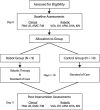Robot enhanced stroke therapy optimizes rehabilitation (RESTORE): a pilot study
- PMID: 33478563
- PMCID: PMC7819212
- DOI: 10.1186/s12984-021-00804-8
Robot enhanced stroke therapy optimizes rehabilitation (RESTORE): a pilot study
Abstract
Background: Robotic rehabilitation after stroke provides the potential to increase and carefully control dosage of therapy. Only a small number of studies, however, have examined robotic therapy in the first few weeks post-stroke. In this study we designed robotic upper extremity therapy tasks for the bilateral Kinarm Exoskeleton Lab and piloted them in individuals with subacute stroke. Pilot testing was focused mainly on the feasibility of implementing these new tasks, although we recorded a number of standardized outcome measures before and after training.
Methods: Our team developed 9 robotic therapy tasks to incorporate feedback, intensity, challenge, and subject engagement as well as addressing both unimanual and bimanual arm activities. Subacute stroke participants were assigned to a robotic therapy (N = 9) or control group (N = 10) in a matched-group manner. The robotic therapy group completed 1-h of robotic therapy per day for 10 days in addition to standard therapy. The control group participated only in standard of care therapy. Clinical and robotic assessments were completed prior to and following the intervention. Clinical assessments included the Fugl-Meyer Assessment of Upper Extremity (FMA UE), Action Research Arm Test (ARAT) and Functional Independence Measure (FIM). Robotic assessments of upper limb sensorimotor function included a Visually Guided Reaching task and an Arm Position Matching task, among others. Paired sample t-tests were used to compare initial and final robotic therapy scores as well as pre- and post-clinical and robotic assessments.
Results: Participants with subacute stroke (39.8 days post-stroke) completed the pilot study. Minimal adverse events occurred during the intervention and adding 1 h of robotic therapy was feasible. Clinical and robotic scores did not significantly differ between groups at baseline. Scores on the FMA UE, ARAT, FIM, and Visually Guided Reaching improved significantly in the robotic therapy group following completion of the robotic intervention. However, only FIM and Arm Position Match improved over the same time in the control group.
Conclusions: The Kinarm therapy tasks have the potential to improve outcomes in subacute stroke. Future studies are necessary to quantify the benefits of this robot-based therapy in a larger cohort.
Trial registration: ClinicalTrials.gov, NCT04201613, Registered 17 December 2019-Retrospectively Registered, https://clinicaltrials.gov/ct2/show/NCT04201613 .
Keywords: Robotic rehabilitation; Robotics; Stroke rehabilitation; Subacute stroke.
Conflict of interest statement
SHS is co-founder and CSO of Kinarm that commercializes the robotic technology used in the present study.
Figures




References
-
- Cotoi A, Anderson A, Vermeer J, Al-Ibrahim F, McIntyre A, Teasell R. Timing of motor rehabilitation after stroke: evidence from randomized controlled trials (RCTs) Int J Stroke. 2017;12(4S):50–51.
-
- Daly JJ, McCabe JP, Holcomb J, Monkiewicz M, Gansen J, Pundik S. Long-dose intensive therapy is necessary for strong, clinically significant, upper limb functional gains and retained gains in severe/moderate chronic stroke. Neurorehabil Neural Repair. 2019;33(7):523–537. doi: 10.1177/1545968319846120. - DOI - PMC - PubMed
-
- Bernhardt J, Hayward KS, Kwakkel G, Ward NS, Wolf SL, Borschmann K, et al. Agreed definitions and a shared vision for new standards in stroke recovery research: The Stroke Recovery and Rehabilitation Roundtable taskforce. Int J Stroke. 2017;12(5):444–450. doi: 10.1177/1747493017711816. - DOI - PubMed
Publication types
MeSH terms
Associated data
Grants and funding
LinkOut - more resources
Full Text Sources
Medical
Miscellaneous

